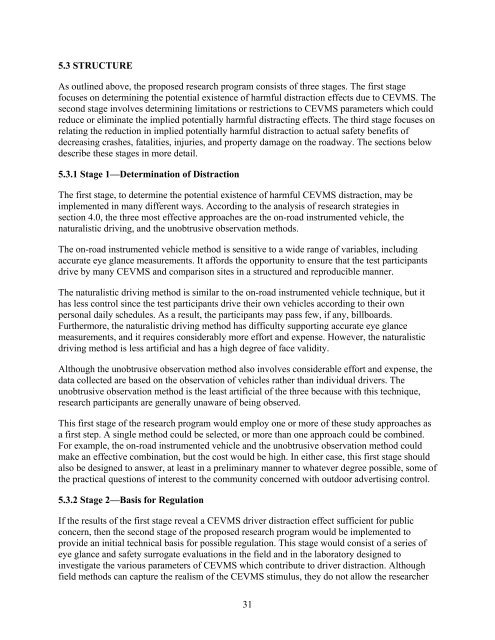The Effects of Commercial Electronic Variable Message Signs ...
The Effects of Commercial Electronic Variable Message Signs ...
The Effects of Commercial Electronic Variable Message Signs ...
You also want an ePaper? Increase the reach of your titles
YUMPU automatically turns print PDFs into web optimized ePapers that Google loves.
5.3 STRUCTURE<br />
As outlined above, the proposed research program consists <strong>of</strong> three stages. <strong>The</strong> first stage<br />
focuses on determining the potential existence <strong>of</strong> harmful distraction effects due to CEVMS. <strong>The</strong><br />
second stage involves determining limitations or restrictions to CEVMS parameters which could<br />
reduce or eliminate the implied potentially harmful distracting effects. <strong>The</strong> third stage focuses on<br />
relating the reduction in implied potentially harmful distraction to actual safety benefits <strong>of</strong><br />
decreasing crashes, fatalities, injuries, and property damage on the roadway. <strong>The</strong> sections below<br />
describe these stages in more detail.<br />
5.3.1 Stage 1—Determination <strong>of</strong> Distraction<br />
<strong>The</strong> first stage, to determine the potential existence <strong>of</strong> harmful CEVMS distraction, may be<br />
implemented in many different ways. According to the analysis <strong>of</strong> research strategies in<br />
section 4.0, the three most effective approaches are the on-road instrumented vehicle, the<br />
naturalistic driving, and the unobtrusive observation methods.<br />
<strong>The</strong> on-road instrumented vehicle method is sensitive to a wide range <strong>of</strong> variables, including<br />
accurate eye glance measurements. It affords the opportunity to ensure that the test participants<br />
drive by many CEVMS and comparison sites in a structured and reproducible manner.<br />
<strong>The</strong> naturalistic driving method is similar to the on-road instrumented vehicle technique, but it<br />
has less control since the test participants drive their own vehicles according to their own<br />
personal daily schedules. As a result, the participants may pass few, if any, billboards.<br />
Furthermore, the naturalistic driving method has difficulty supporting accurate eye glance<br />
measurements, and it requires considerably more effort and expense. However, the naturalistic<br />
driving method is less artificial and has a high degree <strong>of</strong> face validity.<br />
Although the unobtrusive observation method also involves considerable effort and expense, the<br />
data collected are based on the observation <strong>of</strong> vehicles rather than individual drivers. <strong>The</strong><br />
unobtrusive observation method is the least artificial <strong>of</strong> the three because with this technique,<br />
research participants are generally unaware <strong>of</strong> being observed.<br />
This first stage <strong>of</strong> the research program would employ one or more <strong>of</strong> these study approaches as<br />
a first step. A single method could be selected, or more than one approach could be combined.<br />
For example, the on-road instrumented vehicle and the unobtrusive observation method could<br />
make an effective combination, but the cost would be high. In either case, this first stage should<br />
also be designed to answer, at least in a preliminary manner to whatever degree possible, some <strong>of</strong><br />
the practical questions <strong>of</strong> interest to the community concerned with outdoor advertising control.<br />
5.3.2 Stage 2—Basis for Regulation<br />
If the results <strong>of</strong> the first stage reveal a CEVMS driver distraction effect sufficient for public<br />
concern, then the second stage <strong>of</strong> the proposed research program would be implemented to<br />
provide an initial technical basis for possible regulation. This stage would consist <strong>of</strong> a series <strong>of</strong><br />
eye glance and safety surrogate evaluations in the field and in the laboratory designed to<br />
investigate the various parameters <strong>of</strong> CEVMS which contribute to driver distraction. Although<br />
field methods can capture the realism <strong>of</strong> the CEVMS stimulus, they do not allow the researcher<br />
31

















